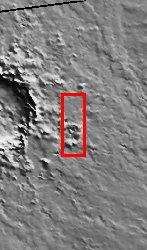- Original Caption Released with Image:
-

(Released 30 July 2002)
Located roughly equidistant between two massive volcanoes, the approximately 60 km Poynting Crater and its ejecta have experienced an onslaught of volcanic activity. Pavonis Mons to the south and Ascraeus Mons to the north are two of the biggest volcanoes on Mars. They have supplied copious amounts of lava and presumably, ash and tephra to the region. This THEMIS image captures evidence for these volcanic materials. The rugged mound of material that dominates the center of the image likely is ejecta from Poynting Crater just 40 km to the west (see MOLA context image). The textural features of this mound are surprisingly muted, giving the appearance that the image is out of focus or has atmospheric obscuration. But the surrounding terrain shows clear textural details and the mound itself displays tiny craters and protruding peaks that demonstrate the true clarity of the image. One conclusion is that the ejecta mound is covered by a mantle of material that could be related to its proximity to the big volcanoes. The tephra and ash deposits produced by these volcanoes could easily accumulate to a thickness that would bury any textural details that originally existed on the ejecta mound. In contrast, the lava flows that lap up to the base of the mound show clear textural details, indicating that they came after the eruptive activity that mantled the ejecta mound. Given the fact that any ejecta material is preserved at all suggests that the impact that produced Poynting Crater postdated the major construction phase of the volcanoes.
- Image Credit:
-
NASA/JPL/Arizona State University
Image Addition Date: -
2002-08-05
|

